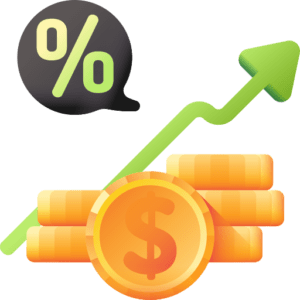Floating Interest Rates and the impact on your investment strategy
Are you an investor looking to make long-term strategic decisions that will pay off in the future? If so, then understanding what a floating interest rate is and how they impact your investments should be top of mind. Floating interest rates are not fixed like other types of loans or financial products but instead change periodically based on the current market conditions. This makes them difficult to predict yet highly important when it comes to planning for your long-term investment strategies. In this blog post, we’ll explore why a fluctuating interest rate is essential to consider when formulating an effective plan for investing and help answer any questions you may have about making the most out of this type of product.
What is a Floating Interest Rate and How Does it Work
A floating interest rate is a type of interest rate that changes periodically with fluctuations in the market. Also known as a variable interest rate, these types of rates are commonly used in loans, mortgages, and other financial products. Unlike a fixed interest rate which remains the same for the entire term of the loan, a floating interest rate is tied to a benchmark rate such as the prime rate or LIBOR, and can go up or down depending on changes in that benchmark rate. The changes in the floating interest rate can have a significant impact on the amount of interest paid over the term of the loan, which is why it’s important to understand how it works and the potential risks involved. To reap the rewards of a floating interest rate, one must weigh the pros and cons carefully before making a decision to opt for such a loan.
Factors that Impact Floating Interest Rates
Floating interest rates can be impacted by a number of factors, some of which are highly unpredictable. One such factor is the policy decisions made by central banks, which can cause interest rates to rise or fall depending on the perceived level of inflation in the economy. Another factor is the health of the broader economy, with positive growth and low unemployment typically leading to higher interest rates. Additionally, changes in the supply and demand for credit can impact floating interest rates, as can geopolitical events and shifts in investor sentiment. Ultimately, the complex interplay of these and other factors make it difficult to predict where floating interest rates will go in the short term, but staying on top of these trends can be an important way to understand the overall health of the economy and make smart financial decisions accordingly.

Examining the Pros and Cons of Floating Interest Rates
In the world of personal finance, interest rates can dictate the success or downfall of an investment. One option for borrowers and lenders alike is floating interest rates. These rates fluctuate based on the current market conditions, providing the potential for both advantages and disadvantages. On one hand, if interest rates decrease, borrowers can benefit from lower payments. However, if rates rise, borrowers may face higher payments and possible financial strain. Similarly, lenders can benefit from higher returns if rates rise but may incur losses if rates fall. Navigating the pros and cons of floating interest rates is a delicate balance, and careful consideration must be taken to evaluate the potential risks and rewards.
Understanding the Risks Associated with Floating Interest Rates
Understanding the risks associated with floating interest rates is crucial for anyone looking to make a financial investment. A floating interest rate, also known as an adjustable-rate, can fluctuate with the market, making it unpredictable and potentially unstable. While a floating interest rate might provide a lower interest rate initially, it can quickly increase, resulting in higher monthly payments. However, with a thorough understanding of floating interest rates, investors can create a plan that balances risk and rewards, making smart decisions for their financial future. By staying informed and staying ahead of market trends, investors can make smarter choices when it comes to their loans, mortgages, and other financial endeavors.
Strategies to Implement for a Successful Investment Strategy with Floating Interest Rates
When investing in an environment with floating interest rates, it’s essential to develop a robust strategy that can adapt to changing market conditions. One effective approach is to diversity your portfolio across different asset classes to mitigate risk and capitalize on opportunities. Consider investing in fixed-income instruments, such as bonds and treasury bills, which can provide a steady stream of income and also offer protection against inflation. Another strategy is to stay up-to-date with market trends and economic indicators to identify potential risks and opportunities. By keeping a close eye on interest rate movements, you can make informed decisions about when to buy and sell investments. Ultimately, a successful investment strategy requires a disciplined approach, good research, and a willingness to take calculated risks.
Adjusting Your Investment Portfolio Based on Current Conditions and Future Predictions
Investing can be a tricky game. Sometimes the market is up, other times it’s down. Predicting the future isn’t always easy, but it’s an essential part of making investment decisions. Adjusting your portfolio based on current conditions and future predictions is key to maximizing your returns. This means analyzing economic indicators, keeping an eye on industry trends, and staying up to date with company news. While it can be tempting to make drastic changes when the market takes a dip, it’s important to remember that investing is a long-term game. By carefully considering current and future conditions, you can make informed decisions that will help you achieve your financial goals.

Floating interest rates can be a powerful tool for investors and provide an opportunity to command higher returns than fixed rate borrowing. However, with greater reward comes higher risk so it’s important to stay informed of market trends and current conditions. Keeping a pulse on rates is the key to success when using floating interest rates; understanding the impactful changes as they come along as well as how those changes might affect your investment strategies are both essential. With the right information and processes in place, you can make informed decisions when it comes to your investments and develop an effective strategy that includes floating interest rates. Not only will this help you maximize your investments, but also enable you to mitigate possible risks. To stay ahead of future predictions and updated stock market news, opt in to the email newsletter for more investment insights.




